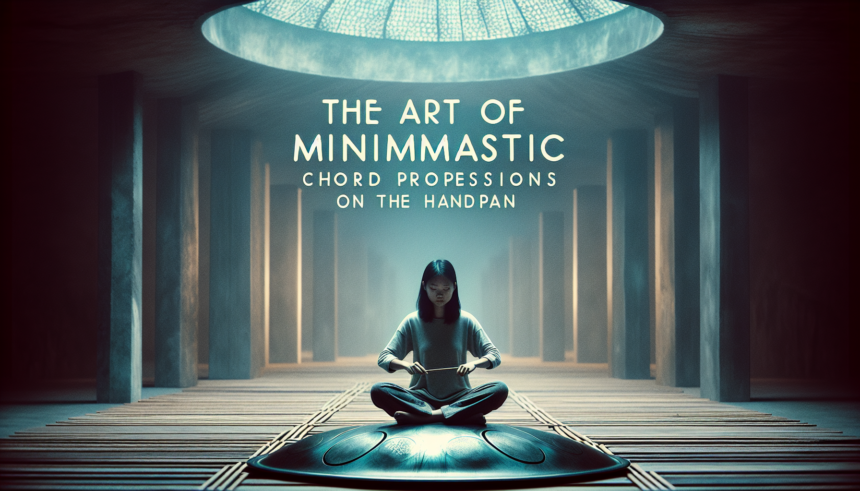<!DOCTYPE html>
<html lang="en">
<head>
<meta charset="UTF-8">
<meta name="viewport" content="width=device-width, initial-scale=1.0">
<title>Handpan Minimalistic Chord Progressions</title>
</head>
<body>
<h1>The Art of Minimalistic Chord Progressions on the Handpan</h1>
<p>The handpan, with its ethereal and otherworldly tones, has captured the hearts of musicians and listeners around the globe. Its hauntingly beautiful soundscapes lend themselves well to a variety of musical genres. Among the numerous playing styles that can be explored on this unique instrument, minimalistic chord progressions stand out as a powerful method of creating evocative and moving pieces. The art of minimalistic chord progressions on the handpan involves using fewer notes and simpler chord structures to convey profound emotion and depth.</p>
<h2>Understanding Minimalism in Music</h2>
<p>Minimalism in music is characterized by simplicity and repetition. It prioritizes the essence of sound over complexity, often relying on repetitive motifs, reduced ornamentation, and a focus on tonal purity. This approach to composition and performance strips away excess, providing a direct pathway to the listener's emotions. The handpan’s natural resonance is particularly suited to this style, as its clear, sustained tones need little embellishment to create a rich auditory experience.</p>
<h2>The Unique Qualities of the Handpan</h2>
<p>The handpan, in essence, is a steel drum with a series of tuned notes. Each note is carefully hammered and tuned to specific frequencies, creating a harmonious scale. This construction allows for a wide range of tonal possibilities within a limited set of notes. The handpan’s resonance and sustain make each strike linger, creating a seamless flow between notes and chords. These qualities naturally complement the minimalist approach, where fewer notes can create a lasting impact.</p>
<h2>Building Minimalistic Chord Progressions</h2>
<p>To create minimalistic chord progressions on the handpan, one must understand its layout and the scale it is tuned to. Most handpans are tuned to specific scales, such as D minor, C major, or G Aeolian. Familiarizing yourself with these scales is the first step towards crafting effective progressions.</p>
<h3>1. Start Simple</h3>
<p>Begin with basic chords. A simple major or minor triad consists of three notes: the root, the third, and the fifth. For example, in a D minor scale, the D minor chord comprises the notes D, F, and A. Playing these notes in succession or even simultaneously can create a stunningly clear and resonant chord.</p>
<h3>2. Utilize Repetition</h3>
<p>Repetition is a cornerstone of minimalism. Gradually introduce a second chord and move between the two. For instance, pair the D minor chord with an A minor chord (A, C, E). Alternating between these two chords establishes a sense of rhythm and structure without overwhelming complexity.</p>
<h3>3. Explore Sustained Notes</h3>
<p>Take advantage of the handpan’s natural sustain. Allow notes to ring out and overlap slightly, creating a dreamy, continuous sound. This can be particularly effective when moving between chords, as it smoothens the transition and enhances the overall texture of the music.</p>
<h3>4. Add Variations Gradually</h3>
<p>Once comfortable with basic progressions, introduce subtle variations. This might involve altering the order of notes within a chord, omitting certain notes, or adding additional ones sparingly. For example, adding a seventh to the D minor chord (D, F, A, C) can add a new dimension to the piece without departing from the minimalist ethos.</p>
<h3>5. Maintain Spaciousness</h3>
<p>Minimalism thrives on space and the absence of clutter. Resist the temptation to fill every moment with sound. Letting silence or rests contribute to the composition can be as powerful as the notes themselves. The handpan’s resonance ensures that even sparse use of notes can fill the auditory space effectively.</p>
<h2>Techniques for Minimalistic Expression</h2>
<p>In addition to constructing minimalistic chord progressions, various playing techniques can enhance the expressive quality of the handpan within this style.</p>
<h3>1. Dynamic Control</h3>
<p>Manipulating the dynamics – the volume and intensity of each note – can convey a wide range of emotions. Soft, gentle strikes might evoke a sense of calm, while more forceful hits can introduce intensity and urgency. This dynamic variation is crucial for maintaining interest in minimalist pieces, where the note count is intentionally low.</p>
<h3>2. Rhythmic Variation</h3>
<p>Experiment with different rhythms. Even within a minimalist framework, varying the timing and duration of notes can provide a rich tapestry of sound. Syncopation, staggered rhythms, or simple off-beats can add complexity and intrigue without sacrificing the minimalist aesthetic.</p>
<h3>3. Harmonic Overtones</h3>
<p>The handpan naturally produces harmonic overtones – higher-pitched sounds that resonate in response to the primary notes. By slightly changing the stroke location or intensity, players can emphasize these overtones, adding subtle harmonic layers to their minimalist compositions.</p>
<h3>4. Use of Muting</h3>
<p>Intentionally muting notes by touching the metal with the hand can create short, staccato sounds. This technique introduces contrast to the typically long, sustained notes of the handpan, giving the performance an added dimension and helping to maintain the listener's engagement.</p>
<h2>The Emotional Impact of Minimalism</h2>
<p>Minimalistic music often evokes strong emotional responses. This is largely due to the way it strips down to essential elements, allowing listeners to connect with the fundamental vibrations and resonances. The handpan, with its soulful and meditative tones, can deeply affect listeners, inviting them into a reflective and tranquil state.</p>
<p>By using minimalistic chord progressions, handpan players can create powerful, evocative pieces that resonate on a profound emotional level. This approach encourages introspection and mindfulness, making each performance a unique and personal experience, both for the player and the audience.</p>
<h2>Push the Boundaries of Minimalism</h2>
<p>While minimalistic chord progressions on the handpan rely on simplicity, players are encouraged to push the boundaries and find their unique voice within this framework. Experiment with non-traditional scales, unconventional rhythms, or blending minimalist principles with other musical styles. The goal is to maintain the essence of minimalism while still exploring new possibilities and personal expression.</p>
<h2>Conclusion</h2>
<p>The art of minimalistic chord progressions on the handpan is about discovering the beauty in simplicity. Through the mindful use of notes, rhythms, and dynamics, players can create deeply moving pieces that transcend complexity. The handpan, with its resonant and melodic nature, is a perfect vessel for minimalist music, offering endless potential for emotional expression and connection.</p>
<p>By embracing the minimalist approach, handpan players can craft soundscapes that are both simple and profound, inviting listeners into a world of serene contemplation and emotional resonance. Each note, each chord, and each silence becomes a meaningful part of the musical journey, leaving a lasting impression on all who experience it.</p>
<h2>FAQs</h2>
<h3>1. What scales are best for minimalistic chord progressions on the handpan?</h3>
<p>Scales such as D minor, C major, and G Aeolian are popular choices for minimalistic chord progressions due to their harmonic richness and simplicity. However, any scale can be used effectively if approached with a minimalist mindset.</p>
<h3>2. How can I ensure my minimalistic handpan music remains engaging?</h3>
<p>Maintaining dynamic control, rhythmic variation, and employing techniques like sustained notes, harmonic overtones, and occasional muting can keep your minimalist handpan music engaging and emotionally resonant.</p>
<h3>3. Is it necessary to have extensive musical training to play minimalistic handpan music?</h3>
<p>Not necessarily. While a basic understanding of musical theory and scales is helpful, the intuitive layout and resonance of the handpan make it accessible to beginners. The emphasis on simplicity and repetition in minimalism can be a great way for newcomers to start making beautiful music quickly.</p>
<h3>4. Can I blend minimalism with other musical styles on the handpan?</h3>
<p>Absolutely! Minimalism is a versatile approach that can complement various musical styles. Experiment blending minimalistic principles with different genres to create unique and engaging pieces.</p>
<h3>5. How do I choose the right handpan for playing minimalistic music?</h3>
<p>Choosing a handpan with a scale that resonates with you is crucial. Consider the scale, the quality of the instrument, and how the notes complement each other. Playing and listening to different handpans can help you find the one that suits your minimalistic musical vision.</p>
</body>
</html>The Art of Minimalistic Chord Progressions on the Handpan

Leave a comment




